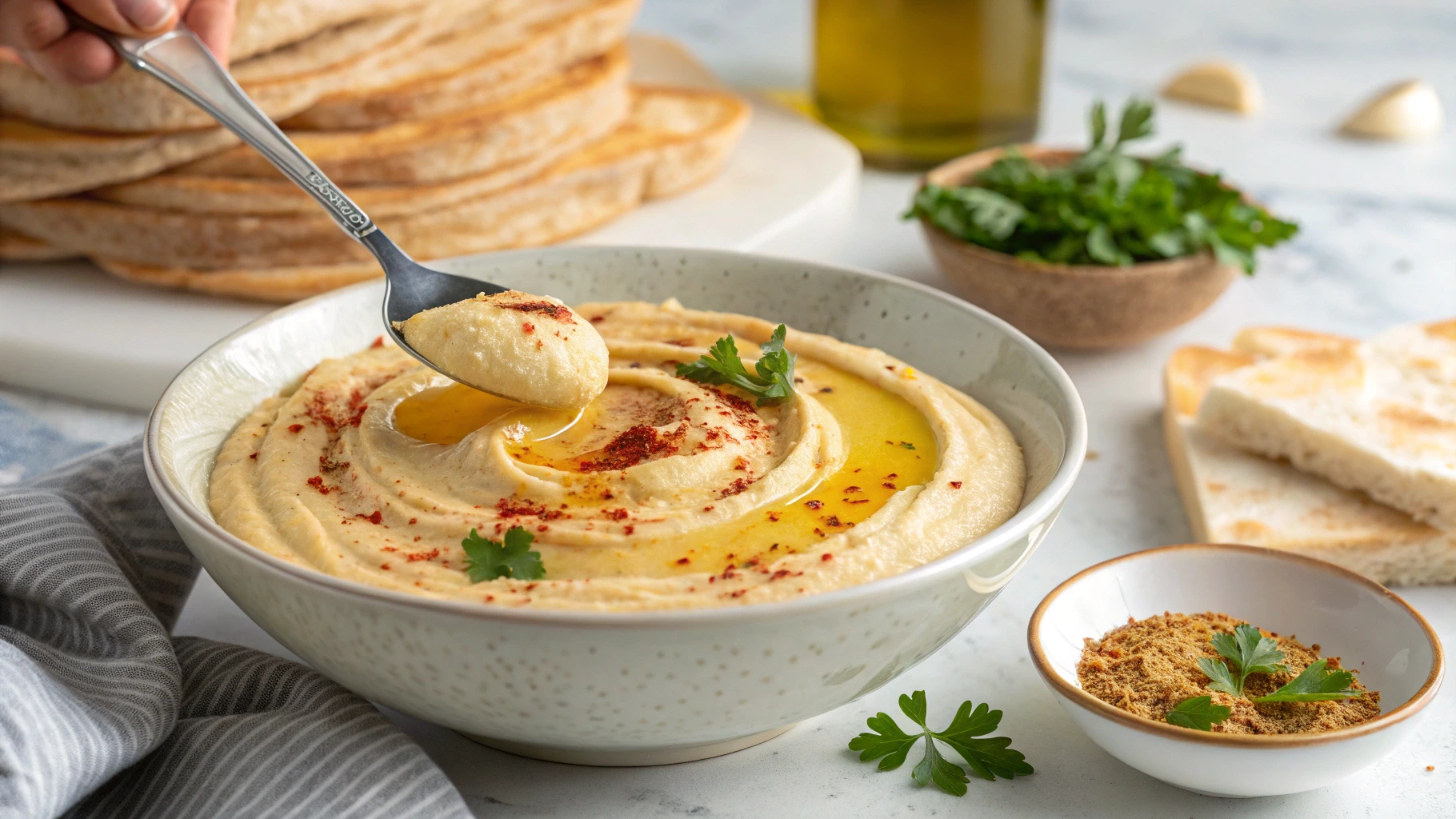If you’re looking for a creamy, healthy, and flavorful dip, hummus is the perfect choice! This traditional Middle Eastern dish has been enjoyed for centuries and is now a favorite worldwide. Packed with plant-based protein, fiber, and heart-healthy fats, hummus is not only delicious but also a nutrient-rich food that fits into a variety of diets.
But what makes hummus so special? chickpeas, the main ingredient in hummus, are rich in essential nutrients that support digestion, blood sugar control, and heart health. Plus, the use of extra virgin olive oil in hummus provides powerful antioxidants and healthy fats, making it a superfood snack.
Whether you enjoy it as a dip, a spread, or part of a hearty meal, hummus is one of the most versatile and satisfying dishes you can make, and it couldn’t be easier. In this guide, we’ll explore the secrets to perfect homemade hummus, from its rich history and impressive health benefits to simple, step-by-step instructions.
Craving more wholesome, homemade favorites? Be sure to check out our Creamy Mushroom and Asparagus Chicken Penne, a hearty main course that pairs beautifully with lighter sides like hummus.
Table of Contents
ToggleA Taste of the Orient: The History of Hummus
Hummus has been a staple in Middle Eastern and Mediterranean cuisine for centuries, deeply woven into the cultural and culinary traditions of the region. While its exact origin remains a topic of debate, countries such as Lebanon, Syria, and Egypt all claim to have been the first to create this iconic dish. What is undeniable, however, is its long-standing presence in historical texts and traditional cooking.
1. Ancient Origins & Early Mentions of Hummus
Though we may never know who made hummus first, the earliest written records of a dish resembling hummus date back to the 13th century, found in Arabic cookbooks from the Levant and Egypt. These historical texts describe a pureed chickpea dish mixed with vinegar, lemon, and herbs, closely resembling the hummus we know today.
Some historians believe that hummus may have even been eaten long before written records existed, as chickpeas, one of the world’s oldest cultivated legumes, have been a dietary staple for over 10,000 years. Ancient civilizations, including the Greeks, Romans, and Persians, frequently consumed chickpeas, making it possible that early versions of hummus existed in multiple regions.
2. Hummus Across Cultures: A Shared Heritage
As hummus spread across the Middle East, North Africa, and Southern Europe, different cultures put their own spin on the dish. While the core ingredients, chickpeas, tahini, olive oil, garlic, and lemon juice, remained the same, subtle variations emerged:
- Lebanese Hummus – Extra creamy, often served with whole chickpeas and olive oil.
- Syrian Hummus – Rich and smooth, sometimes incorporating cumin for extra depth.
- Egyptian Hummus – Often spiced with more garlic and sometimes mixed with ful (fava beans).
- Turkish Hummus – Occasionally includes yogurt for a tangy twist.
Each country takes pride in its own version of hummus, and to this day, debates continue over which nation can claim it as their own.
3. The Global Rise of Hummus: From Local Dish to Worldwide Favorite
Over the years, hummus has transcended its Middle Eastern roots and become a global sensation. In the 20th century, Lebanese and Jewish immigrants brought hummus to Europe and North America, where it quickly gained popularity.
- 1980s: Health-conscious trends fueled interest in plant-based and high-protein foods.
- 1990s: Supermarkets started selling pre-packaged hummus, making it accessible to a global audience.
- 2000s-Present: Hummus became a staple in vegan and Mediterranean diets, with creative variations emerging worldwide.
Today, hummus is one of the most widely consumed dips in the world, appearing in restaurants, meal preps, lunchboxes, and supermarket shelves. It is enjoyed in countless ways, from classic pita dipping to innovative fusion dishes like hummus toast, hummus pizza, and even hummus-based desserts!
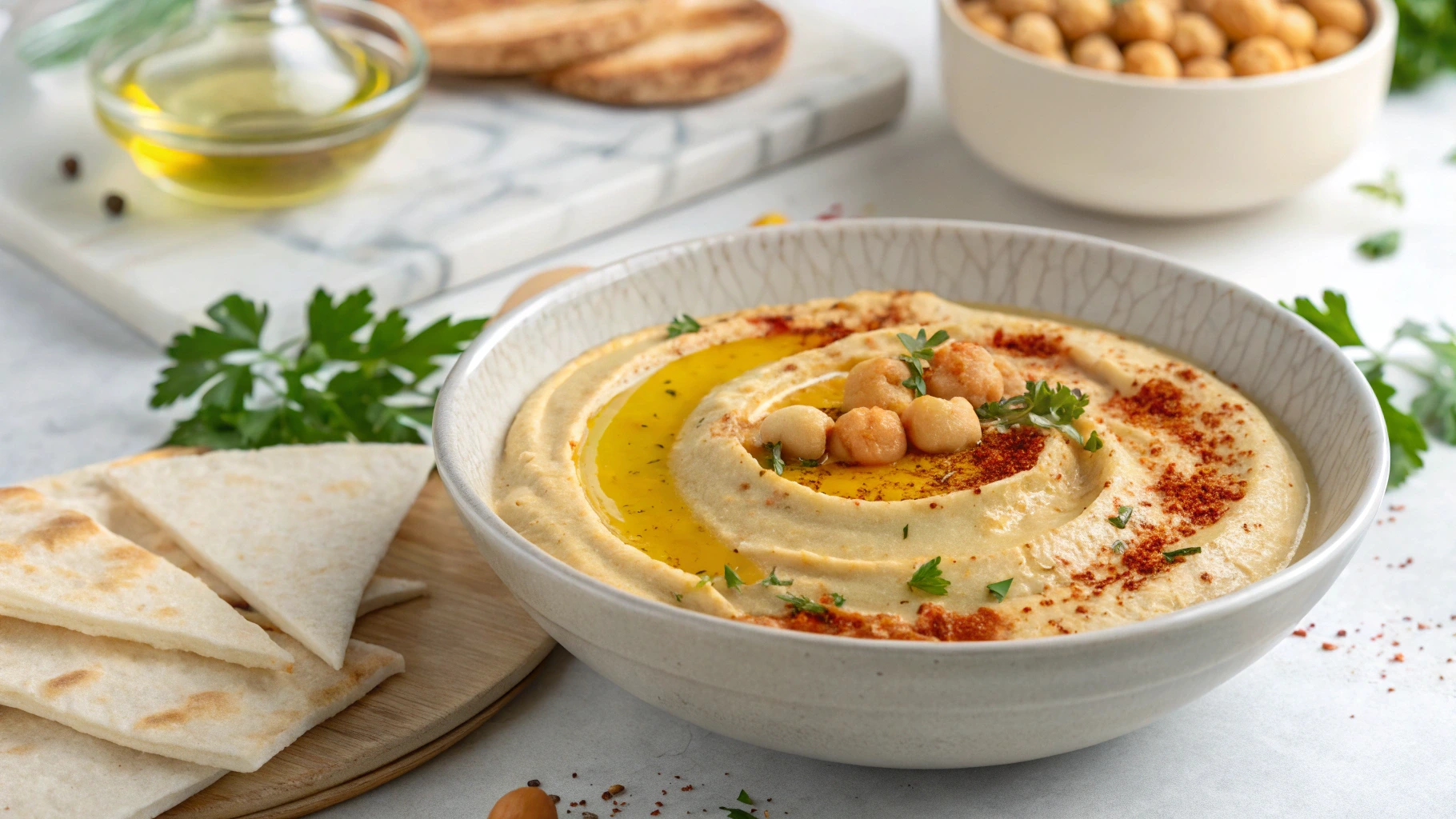
Why Hummus Remains So Popular Today
Hummus has stood the test of time for a simple yet powerful reason: it is both delicious and incredibly nutritious. Its simple ingredients make it an ideal choice for:
- Health-conscious eaters – Packed with protein, fiber, and heart-healthy fats.
- Vegan & vegetarian diets – A perfect plant-based protein source.
- Gluten-free and allergen-friendly meals – Naturally free from gluten, nuts, and dairy.
- Quick and easy meals – A no-fuss, ready-in-minutes dip and spread.
From its humble beginnings in Middle Eastern kitchens to its worldwide fame, hummus has proven to be more than just a dip, it is a symbol of shared history, culinary artistry, and wholesome eating. Whether you enjoy it in a traditional mezze platter or spread over a sandwich, one thing is certain: hummus is here to stay!
Essential Ingredients for the Best Hummus
For a smooth and creamy hummus, using fresh, high-quality ingredients is key. Here’s what you’ll need:
- Chickpeas (Garbanzo Beans) – The base of hummus. Use dried chickpeas for the best texture or canned chickpeas for convenience.
- Tahini – A rich sesame paste that adds depth and nuttiness to the hummus.
- Olive Oil – Always use extra virgin olive oil for an authentic, smooth finish.
- Fresh Garlic – Adds a bold, aromatic taste (roasting garlic makes it milder).
- Lemon Juice – Freshly squeezed for a bright, tangy balance.
- Salt & Spices – Cumin, paprika, and sumac enhance the flavor.

How to Make Creamy, Authentic Hummus
1. Prepare the Chickpeas
- If using dried chickpeas, soak them overnight in water.
- The next day, drain and cook them in boiling water for 1.5-2 hours until soft.
- If using canned chickpeas, simmer them for 20 minutes to make them extra tender.
2. Peel the Chickpeas for a Smoother Texture
- Add 1 teaspoon of baking soda to the cooked chickpeas and let sit for a few minutes.
- Rub them under running water—the skins will peel off easily!
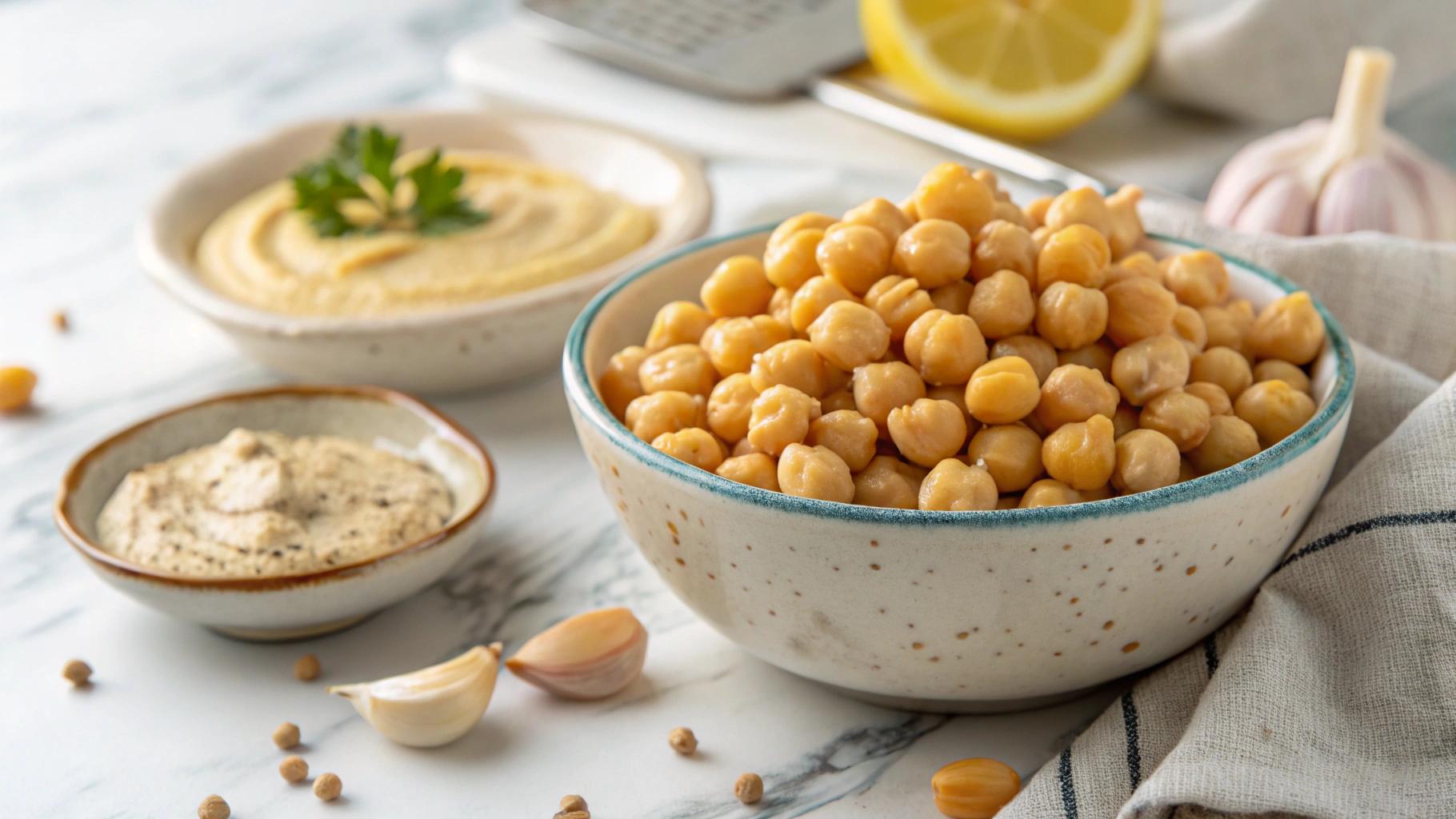
3. Blend the Chickpeas Until Creamy
- Add the chickpeas to a food processor and blend into a smooth paste.
- Add tahini, lemon juice, garlic, and spices.
- Blend for 3-5 minutes until fluffy.
4. Adjust Consistency & Flavor
- Slowly drizzle in olive oil while blending.
- If too thick, add small amounts of cold water until smooth.
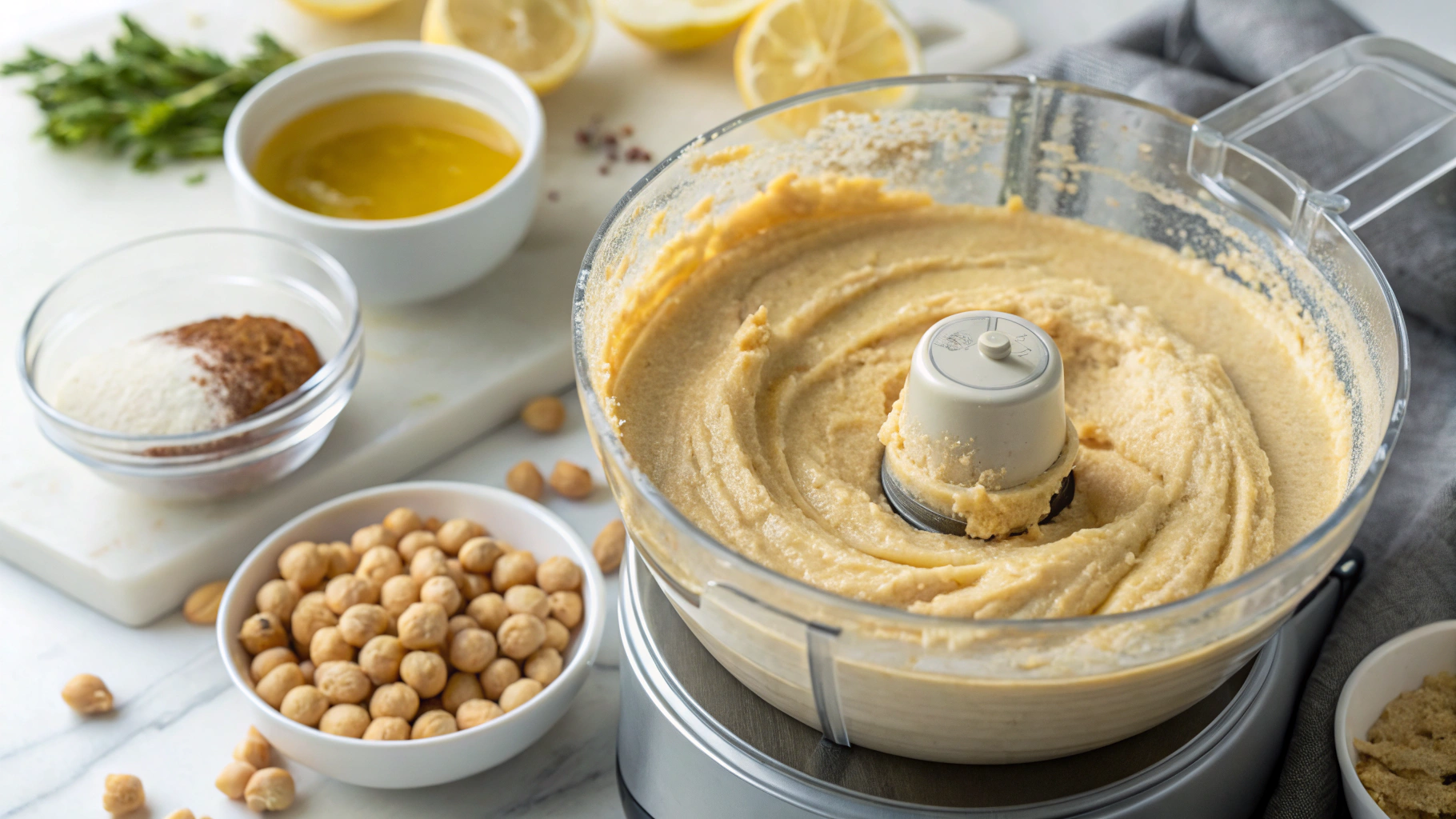
5. Serve & Garnish
- Transfer to a bowl and drizzle with olive oil.
- Garnish with paprika, sumac, fresh parsley, and whole chickpeas.
- Serve with warm pita bread, fresh veggies, or crackers!
Creative Hummus Variations
Want to mix things up? Try these delicious hummus flavors:
🌶️ Spicy Hummus – Add chili flakes or harissa for extra heat.
🥑 Avocado Hummus – A creamy twist with added healthy fats.
🧄 Roasted Garlic Hummus – Caramelized garlic gives it a deep, rich flavor.
🥕 Carrot Hummus – Roasted carrots add sweetness and extra nutrients.
🍫 Chocolate Hummus – A sweet, dessert-style hummus with cocoa powder and maple syrup.
The Best Ways to Serve Hummus
- As a Dip – Pair with pita bread, carrot sticks, cucumbers, or crackers.
- As a Spread – Use it in sandwiches, wraps, or burgers for a protein boost.
- In a Mediterranean Bowl – Add to grilled chicken, quinoa, and veggies.
- As a Pasta Sauce Alternative – Mix with pasta for a creamy, dairy-free sauce.
Hummus is incredibly versatile: serve it with fresh veggies, pita wedges, or alongside dishes like Falafel, a classic Middle Eastern combo that’s satisfying and nourishing.
Health Benefits of Hummus – A Nutritional Powerhouse
Hummus isn’t just a delicious and versatile dip, it’s also packed with incredible health benefits that make it a staple in Mediterranean, vegan, and heart-healthy diets. Made with wholesome ingredients like chickpeas, tahini, olive oil, garlic, and lemon juice, hummus is naturally rich in protein, fiber, and essential nutrients that support overall well-being.
Let’s dive deeper into the science-backed health benefits of hummus and why you should include it in your daily diet!
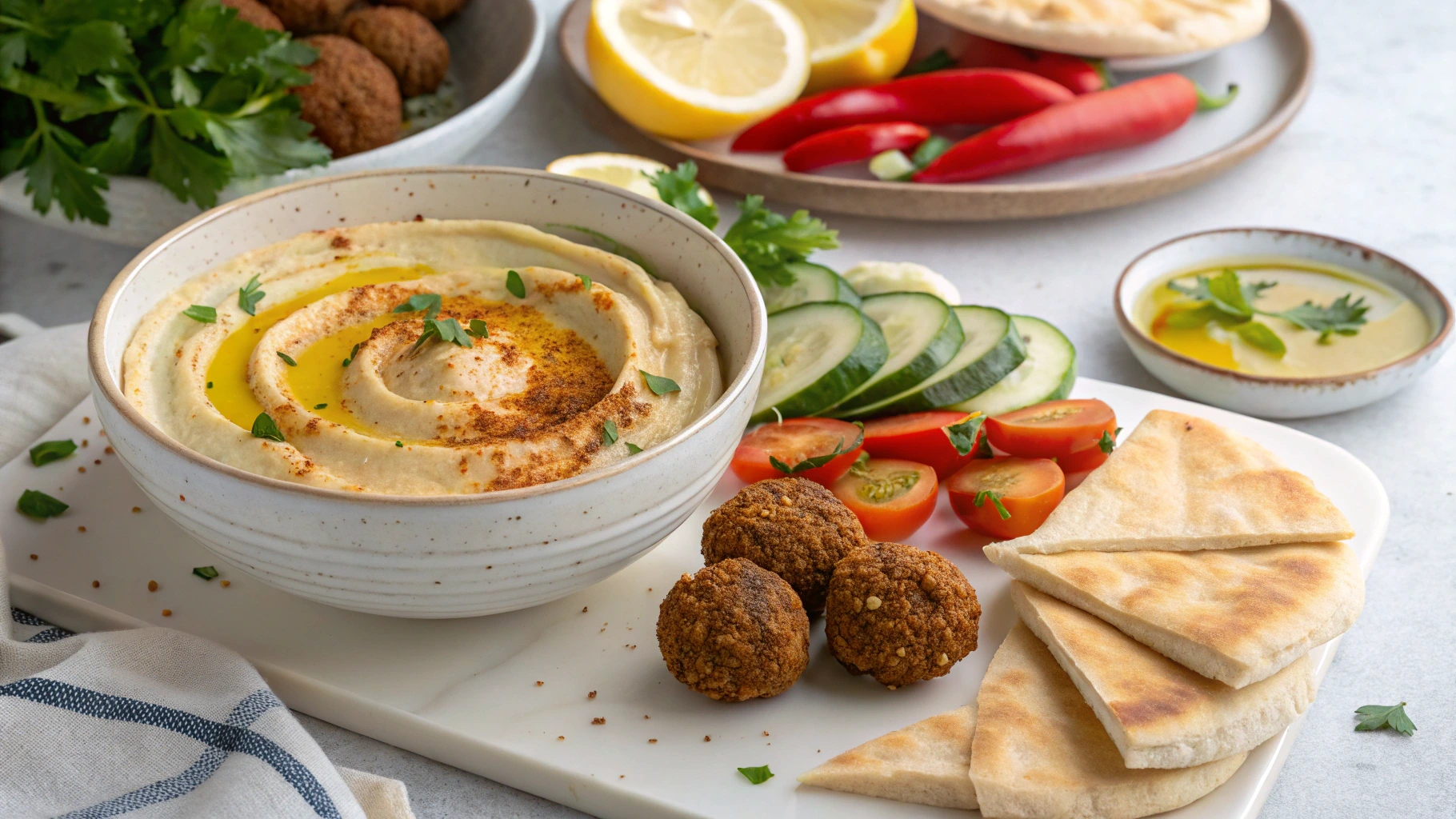
1. High in Fiber & Protein – Supports Digestion & Muscle Recovery
Hummus is an excellent plant-based source of protein and fiber, making it an ideal food for:
- Muscle Recovery – Chickpeas contain all nine essential amino acids, making them a great protein source for vegetarians and vegans.
- Gut Health – The fiber in chickpeas promotes healthy digestion and prevents constipation.
- Sustained Energy – High fiber content helps slow digestion, providing steady energy levels throughout the day.
According to a study published in the Journal of Food Science and Nutrition, legumes like chickpeas improve gut microbiota by promoting the growth of beneficial bacteria, which enhances overall digestive health.
2. Rich in Healthy Fats – Supports Heart Health
One of the standout ingredients in hummus is extra virgin olive oil, which is loaded with monounsaturated fats and antioxidants that promote heart health. Tahini, made from sesame seeds, is also rich in healthy fats and plant-based omega-3s.
How Hummus Benefits Your Heart:
- Reduces bad cholesterol (LDL) – Olive oil helps lower harmful cholesterol levels, reducing the risk of heart disease.
- Supports healthy blood pressure – Chickpeas contain magnesium and potassium, essential for maintaining stable blood pressure levels.
- Fights inflammation – The antioxidants in olive oil and sesame seeds help reduce chronic inflammation, which is linked to heart disease.
A study from the American Journal of Clinical Nutrition found that diets rich in legumes and olive oil reduce the risk of cardiovascular diseases by 30%.
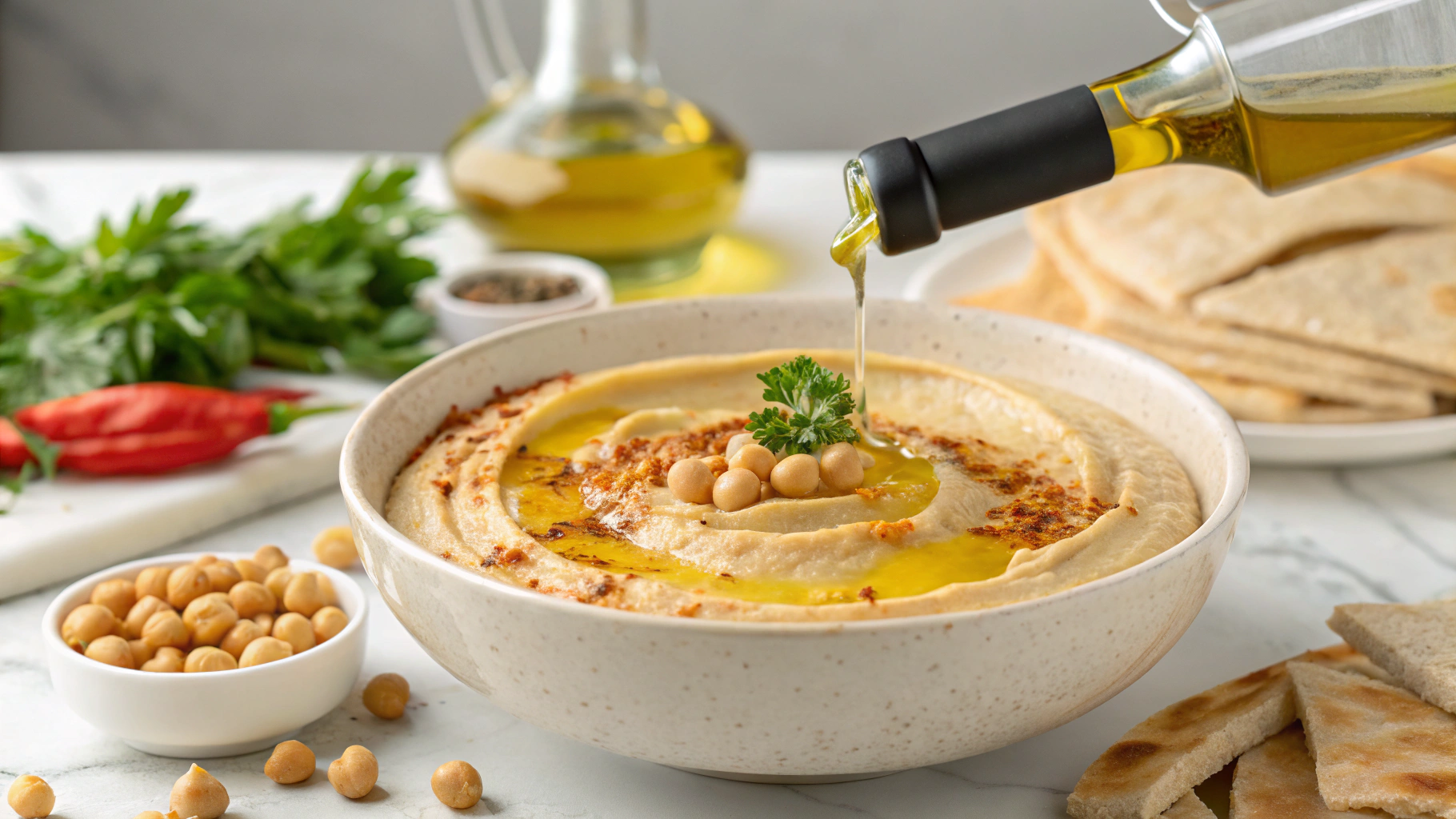
3. Balances Blood Sugar – A Smart Choice for Diabetics
Hummus is a low glycemic index (GI) food, meaning it doesn’t cause rapid spikes in blood sugar levels. Unlike refined carbs or sugary snacks, hummus provides:
- Slow-digesting carbohydrates – Chickpeas release energy gradually, preventing blood sugar crashes.
- High fiber content – Helps regulate blood sugar by slowing down carbohydrate absorption.
- Healthy fats and protein – Both help stabilize insulin levels and keep cravings in check.
A study published in Diabetes Care found that legumes like chickpeas improve insulin resistance and lower blood sugar spikes, making hummus an excellent choice for people with diabetes or those looking to maintain balanced energy levels.
4. Aids in Weight Management – Keeps You Full & Satisfied Longer
If you’re looking for a nutritious snack that supports weight loss, hummus is a fantastic option. Thanks to its high fiber and protein content, hummus helps:
- Reduce hunger cravings – The fiber in chickpeas keeps you feeling full for longer, reducing unnecessary snacking.
- Stabilize appetite hormones – Protein and healthy fats regulate hunger hormones, preventing overeating.
- Promote fat loss – Replacing processed dips and spreads with hummus reduces empty-calorie consumption.
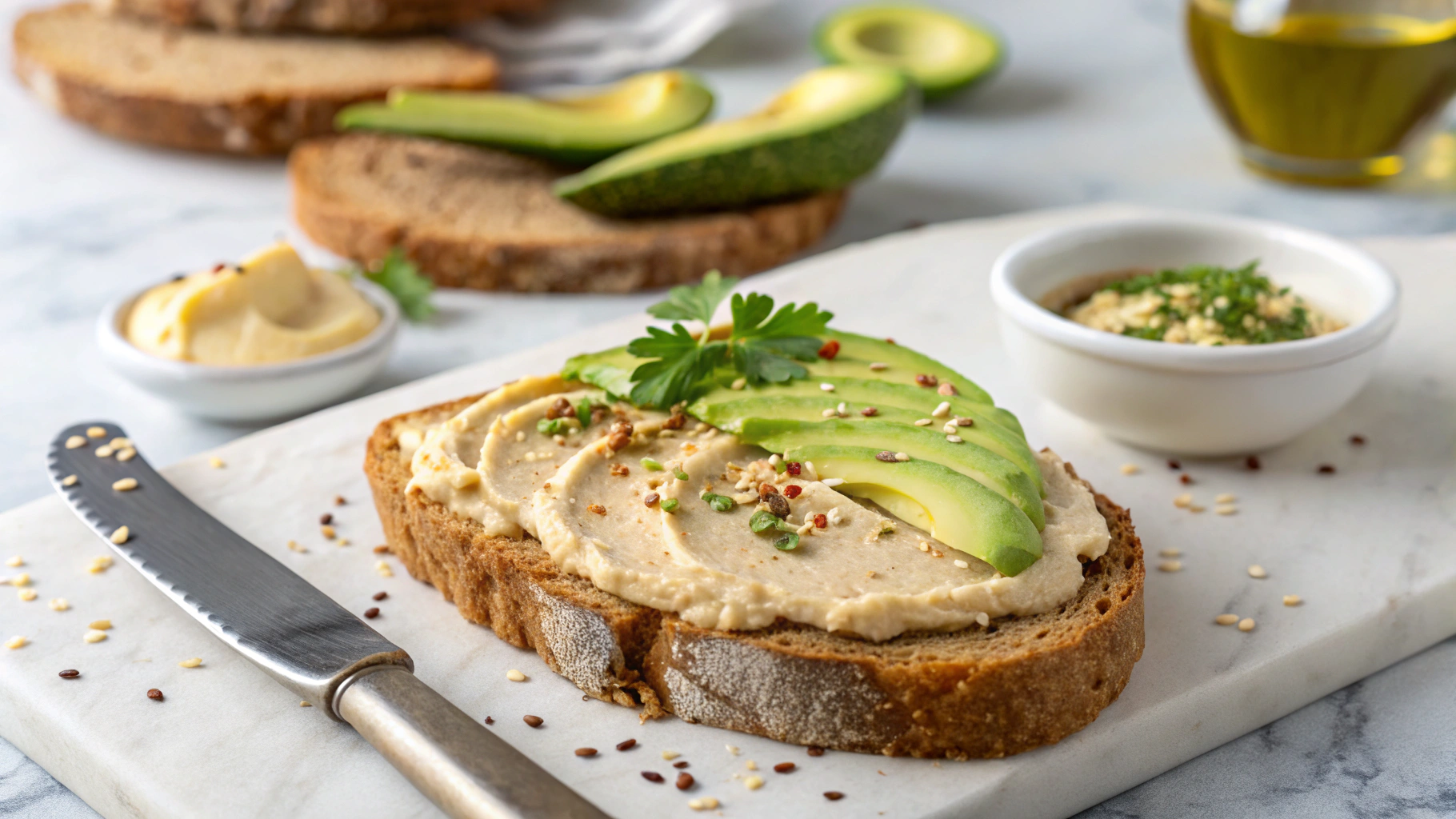
5. Packed with Vitamins & Minerals for Overall Well-Being
Hummus isn’t just high in fiber and protein, it’s also a rich source of essential vitamins and minerals that support your immune system, brain function, and skin health.
Key Nutrients in Hummus:
- Iron – Supports red blood cell production and prevents fatigue.
- Magnesium – Helps with muscle relaxation, heart function, and sleep.
- Zinc – Boosts immune function and promotes wound healing.
- Vitamin B6 – Enhances brain function and mood regulation.
- Calcium – Strengthens bones and teeth, especially from sesame-based tahini.
Frequently Asked Questions About Hummus
❓ Is hummus gluten-free?
👉 Yes! But always check store-bought brands for additives.
❓ Can I freeze hummus?
👉 Yes! Store in an airtight container for up to 3 months.
❓ How long does homemade hummus last?
👉5-7 days in the fridge.
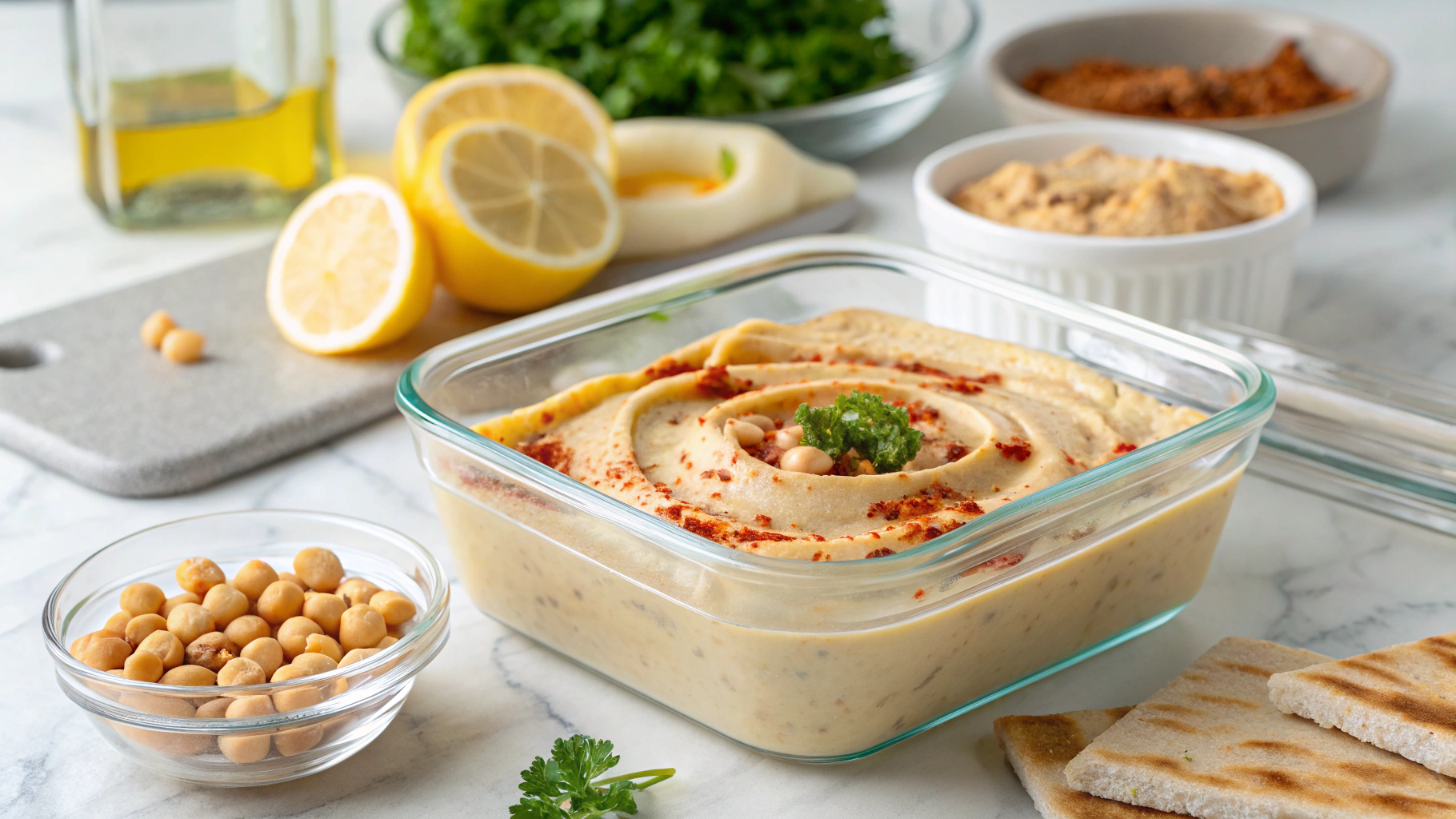
Final Thoughts – Why Hummus is the Ultimate Superfood
Hummus is more than just a tasty dip, it’s a nutrient-packed, versatile dish that fits into any diet. Whether you enjoy it classic, spicy, or sweet, this creamy Middle Eastern spread is the perfect healthy snack, meal addition, or party favorite.
💡 Enjoyed this recipe?
Follow us for daily kitchen tips and tasty inspiration!
📌 Pinterest | 📘 Facebook | 📸 Instagram
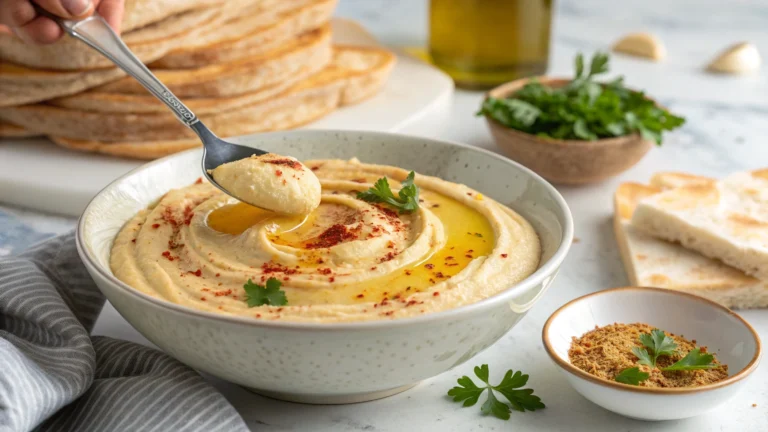
Healthy & Creamy Hummus: A Middle Eastern Delight!
This creamy and healthy homemade hummus is rich in flavor, packed with nutrients, and incredibly easy to make. Perfect as a dip, spread, or side dish!
- Total Time: 10 minutes
- Yield: 4–6 servings 1x
Ingredients
- 2 cups canned or cooked chickpeas (drained, peeled for extra creaminess)
- ¼ cup fresh lemon juice
- ¼ cup tahini (sesame paste)
- 2 cloves garlic (minced)
- 3 tbsp extra virgin olive oil
- ½ tsp ground cumin
- ½ tsp sea salt (adjust to taste)
- 3–5 tbsp ice-cold water (for a smoother texture)
- 1 tsp sumac or paprika (for garnish)
- Fresh parsley & extra olive oil (for garnish)
Instructions
- Prepare the Chickpeas: If using canned chickpeas, drain and rinse them. For ultra-creamy hummus, remove the skins.
- Blend the Base: In a food processor, blend the tahini and lemon juice for 1–2 minutes until creamy.
- Add Ingredients: Add garlic, cumin, salt, and half the olive oil, then blend again.
- Incorporate Chickpeas: Add chickpeas in batches while blending, drizzling in cold water gradually for a smooth consistency.
- Final Touch: Taste and adjust seasoning. Drizzle with remaining olive oil and garnish with sumac, paprika, and parsley.
- Serve & Enjoy: Serve with pita bread, fresh veggies, falafel, or as a spread!
- Author: Norah
- Prep Time: 10 minutes
- Cook Time: 0 minutes (if using canned chickpeas)
- Category: Dip, Spread, Appetizer
- Method: Blended
- Cuisine: Middle Eastern, Mediterranean
- Diet: Vegan
Keywords: hummus recipe, creamy and healthy hummus, homemade hummus, healthy hummus, Middle Eastern dip, easy hummus, best hummus recipe, tahini hummus

